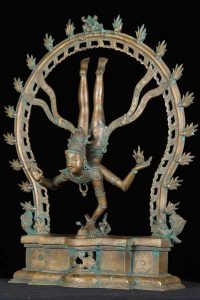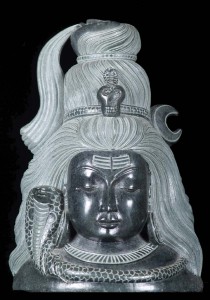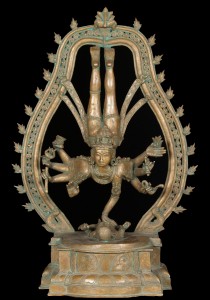Ganges (Ganga) is the most revered and sacred river in the Hindu Mythology. None of the rivers in the world has been able to win so much love and attention from people as Ganga. She is worshipped by the name Ganga Maiya (Mother Ganga) and the Gangajal (Ganga = Ganges; Jal = water) is believed to wash away all sins and grant the devotee salvation. No other river has been mentioned in the Puranas as much as the holy Ganges.
Here is how Lord Vishnu has narrated the importance of river Ganges to Garuda.
“DARSHANATSPARSHANATPANATTATHA GANGETI
KEERTANAT PUNATYAPUNYANPURUSHANA SHATASHOTHA SAHASRASHAH”
Meaning: Thousands of man’s sins are destroyed by the holy sight of the Ganges, and he becomes pure, by the touch of Ganges water, by having it, or by just pronouncing ‘Ganga-Ganga’.
River Ganga
River Ganga originates from the Gangotri glacier at Gaumukh in the Indian Himalayas. She flows 2,525 km across northern India before emptying to the Bay of Bengal in eastern India and Bangladesh.

Birth of Ganga
As per Hindu Mythology, Ganga is the daughter of Brahma, born from his kamandala (a spout shaped vessel), when he was washing the feet of Vamana (The dwarf Brahmin incarnation of Lord Vishnu).
In Valmiki Ramayana, Ganga is depicted as the daughter of King Himavat and Queen Menaka. She is the sister of Parvati, Lord Shiva’s consort.
According to the Vishnu Purana, Ganga was created from the sweat of Lord Vishnu’s feet.
Among the various interesting stories of Ganga, the most popular story is from Bramha Rishi Vishwamitra’s Ramayana Bal Kand, where he narrates about Bhagirath and the descent of Ganga to Earth.
King Sagar – the ruler of Ayodhya and an ancestor of Lord Rama decided to perform the Ashwamedha (great horse sacrifice) to become more powerful. Indra, the king of Gods, became jealous and stole the horse for yaga. Indira tied the horse near Sage Kapila’s ashram, where the sage was meditating in the deep forest. The king along with his 60000 sons began to search for the horse in the nether world and at last found it near Sage Kapila.
Assuming that the sage had stolen the horse, the princes began to insult the sage and tried to free the horse. The princes continued to disturb the meditation of the sage and made him angry. The furious sage with the yogic fire of his eyes burnt all the princes into ashes. King Sagar was disturbed and asked his grandson, Anshuman to search for the princes.
Ashuman’s search ended in the front of the yaga horse and a heap of ash. He also saw the Sage Kapila near to it. He bowed and inquired what happened to the princes. The sage narrated the whole incident and Anusham broke down in grief. He pleaded for forgiveness and for the salvation of the princes. Sage Kapila was pleased and instructed Anushman to bring the holy Ganga to earth as she can only help them to wash away the sin and attain salvation.
In order to attain salvation to his relatives, Anshuman started doing penance on the Himalaya, but it was in vain. His son Dilip also tried to please Lord Brahma and bring Ganga. However, he also failed in his mission. Bhagiratha, the son of Dileep, took penance after his father. Bhagiratha was so dedicated that Lord Brahma was pleased and granted them permission to bring Ganga to earth.
Goddess Ganga was asked to descent to earth, but she felt it as an insult and decided to sweep away everything that came her way. Bhagiratha felt the fierce power in the flow of her current and understood that he needed to do something in order to stop the mighty river from destroying the world. In order to avoid this catastrophe, Bhagiratha prayed to Shiva and requested him to hold Ganga in his matted hair (jata).
At the request of Bhagiratha, Shiva agreed to hold Ganga in his hair locks. At first, Ganga thought that no one would be able to withstand her power and descended to the Earth with all her power. Shiva decided to teach her a lesson and held her in his matted locks. Ganga tried to get free but failed to escape from the Great Shiva. After one year of rigorous penance of Bhagiratha, Shiva was pleased and released Ganga. Ganga understood the greatness of Lord Shiva and asked for his forgiveness. Shiva is known as Gangaadhara as Lord Shiva absorbed the flow of Ganga and saved the earth from flooding, by receiving Ganga on his matted locks.

Shiva was pleased and released Ganga as seven streams – Bhagirathi, Alaknanda, Janhvi, Saraswati, Bhilangana, , Rishiganga, and Mandakini. Ganga followed Bhagiratha, but with her tremendous speed destroyed almost all the nearby villages and forests. Sage Jahnu became angry as his hermitage was drowned by Ganga. By using his yogic power, Sage Jahnu drank the whole Ganga. Bhagiratha pleaded for Sage’s forgiveness and he released Ganga from his thigh by cutting it and for this reason, Ganga is also called ‘Jahnavi’ or ‘Jahnusta’.
Maharishi Agastyaas has emptied all the oceans on Earth by drinking all the water, so Ganga first filled the oceans and quenched the taste to Earth. Ganga touched the ashes of the sixty thousand ancestors of Bhagiratha and blessed them to attain eternal rest in heaven.

